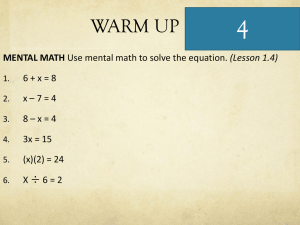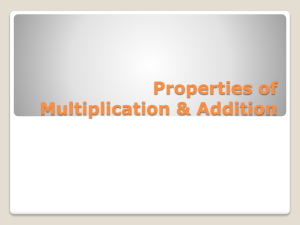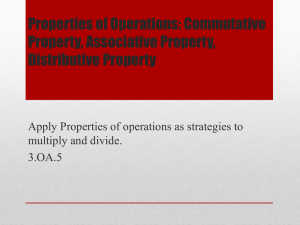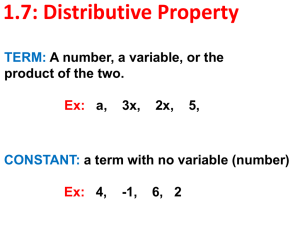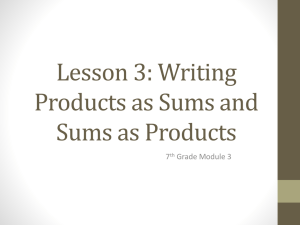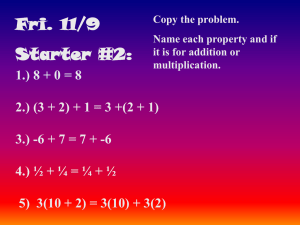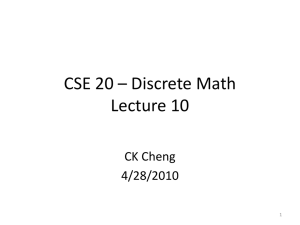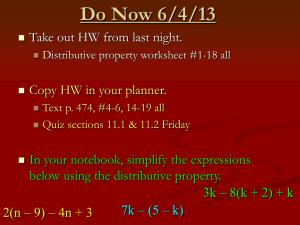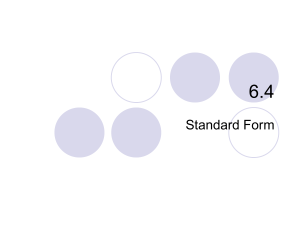Ch 2.6 The Distributive Property
advertisement
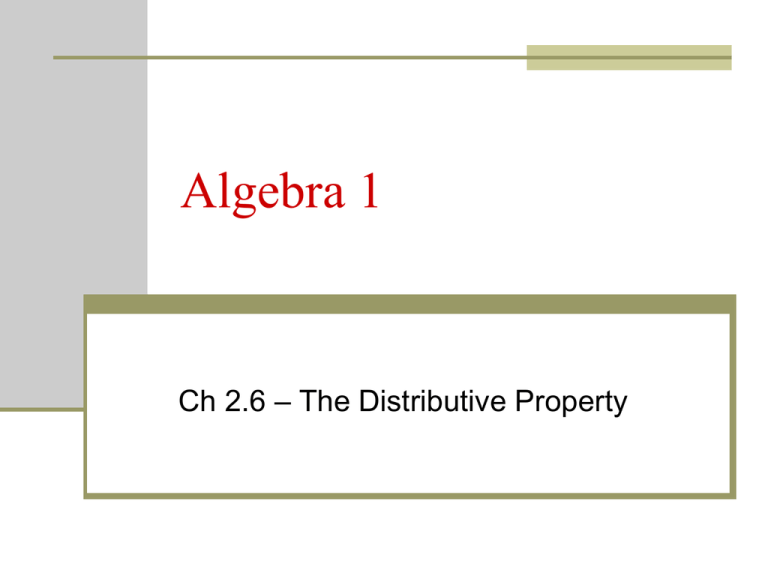
Algebra 1 Ch 2.6 – The Distributive Property Objective Students will use the distributive property Before we begin… The distributive property is a key algebraic concept that looks something like this: 3(x + 4) We will work with this property and its many forms throughout this course… It is expected that you are able to recognize and know how to work with this property… If you cannot recognize and work with the distributive property you will not be successful in this course… The Distributive Property The distributive property states: To multiply a number by a sum or difference, multiply each number inside the parentheses by the number outside the parentheses The distributive property can be used with multiplication and addition or multiplication and subtraction Let’s see what it looks like… Example 1 5(3 + 2) 15 + 10 = 25 Proof: 5(3+2) = 5(5) = 25 Algebraic Expressions The distributive property can be used to re-write algebraic expressions. Use the same process…multiply what’s on the outside of the parenthesis by each term within the parenthesis Let’s see what that looks like… Example 2 3(x + 1) 3x + 3 Note: In this instance 3x and 3 are not like terms. Therefore, you cannot combine them…so the expression is simplified to just 3x + 3 – more on this later in the lesson… Distributive Property There are 2 ways that you can see the distributive property With the multiplier on the left of the parenthesis With the multiplier on the right of the parenthesis Example: 5(2 + 3) OR (b + 3)5 In either event you multiply what’s on the out side of the parenthesis with EACH term inside the parenthesis Comments Again…The distributive property is a key algebraic concept…make no mistake about it…you are REQUIRED to be able to recognize and work with the distributive property if you are to pass Algebra 1! Common Errors The most common error that students make when working the distributive property is that they only multiply what on the outside of the parenthesis with the first term within the parenthesis The other common error is that students get the signs wrong…I do not give partial credit for incorrect signs! Example - Common Error 3(x - 1) 3x - 1 THIS IS INCORRECT! Combining Like Terms In this course you will be expected to simplify expressions by combining like terms… In order to do that you have to be familiar with the vocabulary and know the definition of combining like terms… Let’s take a look at that… Vocabulary Term – is the product of a number and a variable. (product means to multiply) Examples: 3x 3x2 -x -xy2 Three times x Three times x squared Negative 1 times x Negative 1 times x times y squared Vocabulary Coefficient – the coefficient of a term is the number in front of the variable. If there is no number then the coefficient is positive 1. If there is no number and the variable is negative then the coefficient is -1. Examples: -3x x -y 5y2 -3 is the coefficient 1 is the coefficient -1 is the coefficient 5 is the coefficient Vocabulary Like terms – are terms that have the same variable and exponent. They can be combined by adding or subtracting. Examples: 5x + 3x same variable raised to the same power. They can be combined by adding to get 8x 5x2 – 3x2 same variable raised to the same power. They can be combined by subtracting to get 2x2 5x + 3y Different variables raised to the same power – they cannot be combined 5x2 – 3x4 Same variable raised to different powers – they cannot be combined Vocabulary Constants – a number with no variable is called a constant. Constant terms can be combined by adding or subtracting. Examples: 5x + 3 - 2 The constant terms are +3 and – 2. They can be combined to get 5x + 1 - 7 + 6y - 2 The constant terms are – 7 and – 2. They can be combined to get 6y – 9 Simplified Expressions An expression is considered simplified if it has no grouping symbols and all the like terms have been combined Example: -x2 + 5x - 4 - 3x + 2 - x2 cannot be combined with anything because there is no other squared term + 5x and – 3x can be combined because they have the same variable and exponent to get +2x - 4 and + 2 are constant terms and can be combined to get – 2. The simplified expression is: -x2 + 2x - 2 Comments On the next couple of slides are some practice problems…The answers are on the last slide… Do the practice and then check your answers…If you do not get the same answer you must question what you did…go back and problem solve to find the error… If you cannot find the error bring your work to me and I will help… Your Turn Use the distributive property to rewrite the expression without parenthesis 1. 3(x + 4) 2. - (y – 9) 3. x(x + 1) 4. 2(3x – 1) 5. (2x – 4)(-3) Your Turn Simplify by combining like terms 6. 15x + (-4x) 7. 5 – x + 2 8. 4 + a + a 9. 8b + 5 – 3b 10. 9x3 – 2 – 4x3 Your Turn Apply the distributive property then simplify by combining like terms 11. (3x + 1)(-2) + y 12. 4(2 – a) – a 13. - 4(y + 2) – 6y 14. -x3 + 2x(x – x2) 15. 4w2 – w(2w – 3) Your Turn Solutions 1. 3x + 12 8. 4 + 2a 2. -y + 9 9. 5b + 5 3. x2 + x 10. 5x3 – 2 4. 6x – 2 11. -6x – 2 + y 5. -6x + 12 12. 8 – 5a 6. 11x 13. -10y – 8 7. 7 - x 14. -x3 + x2 15. 2w2 + 3w Summary A key tool in making learning effective is being able to summarize what you learned in a lesson in your own words… In this lesson we talked about the distributive property… Therefore, in your own words summarize this lesson…be sure to include key concepts that the lesson covered as well as any points that are still not clear to you… I will give you credit for doing this lesson…please see the next slide… Credit I will add 25 points as an assignment grade for you working on this lesson… To receive the full 25 points you must do the following: Have your name, date and period as well a lesson number as a heading. Do each of the your turn problems showing all work Have a 1 paragraph summary of the lesson in your own words Please be advised – I will not give any credit for work submitted: Without a complete heading Without showing work for the your turn problems Without a summary in your own words…

